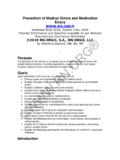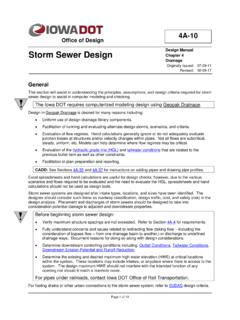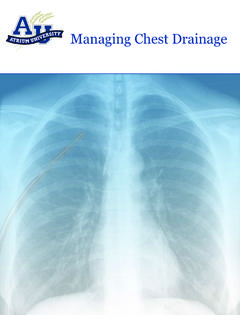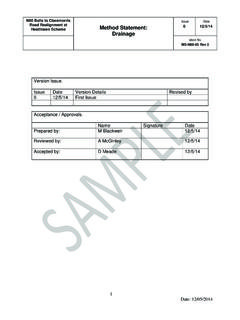Transcription of Chest Tube and Drainage Management - - RN.org®
1 Chest Tube and Drainage Management . Reviewed May, 2017, Expires May, 2019. Provider Information and Specifics available on our Website Unauthorized Distribution Prohibited 2017 , , , LLC. by Patricia Carroll, RN, BC, CEN, RRT Used with Written Permission by Jeffrey P. McGill Throughout this monograph, the terms physician and surgeon are used for convenience. Depending on the practice setting, this role may be filled by an Advanced Practice Registered Nurse or Physician's Assistant. When describing the fluid-filled chambers of a Chest drain, the word water is used for simplicity. Sterile water or sterile saline may be used unless contraindicated by the manufacturer. At the completion of this self-study activity, the learner should be able to . Describe the normal anatomy of the Chest . Explain the changes that occur in the thoracic cavity during breathing.
2 Identify abnormal conditions requiring the use of Chest Drainage . discuss the features of the traditional three-bottle Chest Drainage system. Compare and contrast the traditional three-bottle Chest Drainage system with the self-contained disposable Chest Drainage units available today. Recognize steps in setting up a Chest Drainage system. Outline key aspects of caring for a patient requiring Chest Drainage . recognize four signs indicating a Chest tube can be removed. summarize the use of autotransfusion with Chest drain systems. Water Seal Chamber The water seal chamber is connected to the collection chamber and provides the protection of the one-way valve discussed earlier. The water seal in most disposable Drainage units is formed with an asymmetric U-tube rather than a narrow tube submerged underwater as in the traditional bottle systems.
3 The narrow arm (closest to the collection chamber) is equivalent to the tube; the larger arm serves as the water reservoir. When the fluid reservoir is filled to 2 centimeters above the seal in the U-tube, it has the same effect as submerging the tube in the bottle system 2 centimeters below the surface of the water. In addition to providing the one-way valve, a U-tube design can also be used to measure pressure. When pressures on both sides of the U-tube are equal, the water level is equal in both arms. However, if the pressures on each arm differ, fluid moves away from the side of higher pressure toward the side with lower pressure. If the water seal column on the front of the Chest drain is calibrated with markings, the fluid movement acts as a water manometer for measuring intrapleural pressure, providing additional assessment data for the clinician.
4 Some units have an anti-siphoning float valve in the water seal fluid column that prevents the water from being siphoned out of the water seal chamber and into the collection chamber during situations that create high negative pressures, such as Chest tube stripping. The original design of the float valve at the top of this chamber permitted uncontrolled vacuum levels to accumulate in the patient's Chest with each subsequent stripping of the patient tube (see discussion on Chest tube stripping on page 24, as this practice is no longer recommended for routine care of patients with Chest tubes ). To eliminate this pressure accumulation, manufacturers have also added manual high negative pressure relief valves to Chest drain systems that allow filtered atmospheric air to enter the system to prevent any accumulation of negative pressure in the patient.
5 However, with manual devices, the clinician must recognize the condition of high negativity, evidenced by the rise in the water level in the water seal, and depress the relief valve to remedy the situation. In 1983, automatic high negative pressure protection was introduced. Many systems now employ a float ball design at the top of the water seal chamber with a notch that allows fluid to pass through it. A compartment above the ball holds the water that fills the water seal chamber. Thus, no water spills into the collection chamber, and no water is lost, so the one-way valve protection is not put at risk during conditions of high negative intrapleural pressure. The speed at which disposable systems release accumulating negative pressure varies, depending on the manufacturer and a particular drain's design. Dry Seal Chest Drains Some Chest drains use a mechanical one-way valve in place of a conventional water seal.
6 The mechanical one-way valve allows air to escape from the Chest and prevents air from entering the Chest . An advantage of a mechanical one-way valve is that it does not require water to operate and it is not position-sensitive the way a water-filled chamber is. A dry seal drain protects from air entering the patient's Chest if a drain is knocked over. A drawback to any mechanical one-way valve is that it does not provide the same level of patient assessment information as a conventional water seal; for example, the clinician cannot see changes in the water level reflecting pressure 17. placed high in the Chest to evacuate air, and one tube is placed low in the Chest to drain fluid on the same side. Since the lower tube is likely to drain both fluid and air, it is connected to the major collection chamber. Since the upper tube will mostly evacuate air, it is connected to the minor collection chamber.
7 Double units may also be used in cardiovascular surgery when the surgeon wants to monitor Drainage from two mediastinal tube locations separately. The tube(s) placed below the heart are connected to the major chamber and the tube(s) above the heart are connected to the minor chamber. Or, if a pleural tube is required because the parietal pleura was entered during cardiac surgery (particularly if the internal mammary artery is used for a bypass), the pleural tube can be connected to the minor chamber since it is placed to evacuate air. The mediastinal tubes , draining fluid, are then connected to the major chamber. Infant Chest Drainage Systems The most prominent feature of infant Chest Drainage units is the smaller collection chamber that holds less Drainage than an adult unit. The patient tubing may have a narrower inner diameter compared with adult drains and usually has smaller connectors to connect the patient tubing to the smaller Chest tubes used for infants.
8 Closed Wound Reservoirs Closed wound Drainage systems were originally designed to remove fluid from closed surgical sites; now they are being used for cardiothoracic surgical patients. Bulb suction reservoirs connect to the wound drain and create suction to evac- uate fluid. It must be a completely closed system; any venting to the atmosphere will disrupt the system's selfgenerated suction. In a cardiothoracic patient, a closed system with no vent presents the potential for a catastrophic complication: tension pneumothorax. Chest drains vent to the atmosphere and have positive pressure relief valves for safety, wound drains do not. They can only be used after the lung is expanded and air leaks have sealed. However, not all air leaks are immediately apparent, particularly when there is no water seal or air leak indicator.
9 Whenever an air leak is present, a Drainage catheter must be attached to an appropriate pleural Drainage system to prevent tension pneumothorax. To use a bulb reservoir system, the reservoir is first "activated," creating unmeasured, unregulated suction that is transmitted to the surgical site. When a bulb reservoir is initially compressed and attached to a wound drain, it generates approximately - 120cmH2O suction far more than the carefully regulated -20cmH2O vacuum levels generated by a Chest drain attached to a thoracic catheter. As the reservoir fills, tissues are exposed to varying levels of decreasing suction, and the bedside clinician has no way of knowing the level of suction being applied to the pericardial space or pleural cavity. As the reservoir fills, less negative pressure is present to draw fluid into the reservoir by suction, thus the flow rate of fluid and air leaving the Chest will drop.
10 If the drain fills (100cc) and is not emptied immediately, the pressures between the surgical site and the reservoir will equalize. Since a pressure gradient between the patient and any drain (reservoir) is necessary for Drainage , when pres- sures equalize, Drainage stops. Thus, unlike a Chest Drainage system described above, a bulb reservoir system requires regular maintenance by the nurse to preserve patency. It must be emptied to maintain suction and keep Drainage flow- ing. If pericardial Drainage stops, the patient is at risk for cardiac tamponade. Table 1 compares the characteristics of a Chest drain and a wound drain (reservoir) system. 19. 20. 22. Unfortunately, many patients who need Chest Drainage are tethered to wall vacuum because it has been assumed that pulling air and fluid out of the Chest rather than using gravity Drainage will hasten recovery.















